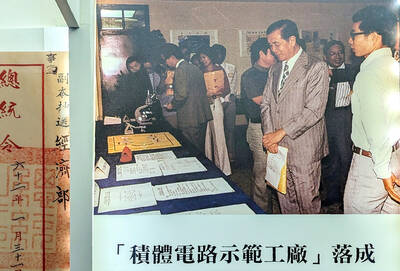Organizing Chinese characters into a dictionary format is not easy. Radicals, stroke counts, phonetic sounds and of course the definitions themselves all compete for the right to bring order, and the unlucky recipient looking for a word or definition may need to be prepared to traipse between books looking for a satisfactory result. As a result, portable electronic dictionaries have become enormously popular and the available range is huge.
However, most are useless for people learning Chinese as a foreign language, since they are tuned for local learners. Luckily, the industry is increasingly taking note of this growing niche, and this article takes a look at two dictionary products that work as learning or reference aids.
XCome Dictionary
Pre-installed on Asus Eee PC
NT$9,500 to NT$20,000, depending on configuration
www.xcome.com
Well-specified dedicated portable
electronic dictionaries are not cheap. Instant Technology’s (快譯通) MD6700 runs in at just under NT$10,000, and for more or less the same price Asus will sell you its Eee PC. “That computer with the funny name” is a full-fledged PC that wirelessly connects to the Internet,
communicates with people with its
integrated Web-cam and mic, and
provides you with professional-grade Microsoft-style software. Into this mix comes XCome’s dictionary, which in Taiwan ships ready to solve your
Chinese and English language problems.
XCome was invited by Asus to create dictionary and language reference software that comes pre-installed on all Linux versions of the Eee PC. As a study aid, it fits pretty well into the armory, sized as it is like a hefty paperback book. The 7-inch screen is small on the basic version and the keyboard a little pokey for those with sausage fingers, but that is what you get when you buy a small computer. Crucially, the unpainted plastic on the cheaper versions and tough solid-state disk drive encourage you to take it anywhere and treat it like a schoolbook.
Opening the dictionary program is simple, though it is unexpectedly located in the “Work” tab of the operating system menu, rather than “Learn.” The user interface is clear, and looking up a word is as straightforward as typing it into the search box. One of the software’s best features is the ability to do “instant lookup” when working in other programs — including while instant messaging, browsing the Internet or working in the included Sun OpenOffice — a suite of free software that aims to challenge Microsoft Office. As you move your mouse over a word, a mini-definition pops up, and you can then jump into the full dictionary to explore more.
The dictionary works with both traditional and simplified Chinese characters, and in most cases the English definition includes a “speak” function, where the word is read out loud, although unfortunately the same luxury is not afforded to the Chinese definition. The product is clearly more suited to learners of English, rather than of Chinese, although it is hard to blame XCome, as Asus specifies which dictionaries should be included and it would be an easy step to improve this.
This impression is reinforced when attempting to type in Chinese. The EeePC software allows typing of traditional characters in Zhuyin Fuhao (注音符號, or Bopomofo), but sadly restricts Hanyu Pinyin (漢語拼音) input to simplified characters.
Overall, the EeePC is a very impressive tool, but one that is tailored more for local learners of English, rather than for beginner-to-intermediate learners of Chinese.
Dr Eye — Han Easy 1.0
Microsoft Windows
US$80
www.dreye.com
Dr Eye, provider of the popular dictionary and translation program for Microsoft Windows, is probably also to blame for much of the poor English translation in Taiwan and over-enthusiastic thesaurus use. No matter — Dr Eye is now launching software aimed at learners of Chinese, so we can make the same mistakes too.
On the surface, it seems like Han Easy is a simple re-skinning of the standard Dr Eye software. The attempt at making the program appear Chinese by styling the interface like ancient scrolls of text — complete with fluted edges and antique buttons — is misguided, but you can’t fault the enthusiasm.
However, the translations impress with their examples set in context, spoken output — and even animated illustrations of the strokes. Tourist attractions and local culinary specialties are proudly introduced, along with basic phrases for travel and survival. It’s clear that Dr Eye is putting considerable effort into tuning this for “foreign” learners of Chinese. Guidebook and dictionary aside, instant translations are available when browsing the Internet or using instant messaging, as on the EeePC.
It seems as if that in trying to work out what foreigners need when learning Chinese, the target audience has become rather blurred, as it includes tourists, students and experts. One also might have to doubt the reality of pulling out a Windows laptop in a busy restaurant to order food. With feedback and time, the software will certainly improve and become less cartoon-like and eager to please. If you want some software for beginners, it is certainly worth a look, but otherwise the powerhouse of Wenlin is more suited to scholars and professional users.
There is more than one way to build a Chinese dictionary. By the same token, there is also more than one type of user. When selecting a dictionary, make sure you ask yourself what you need and choose accordingly.

Oct. 27 to Nov. 2 Over a breakfast of soymilk and fried dough costing less than NT$400, seven officials and engineers agreed on a NT$400 million plan — unaware that it would mark the beginning of Taiwan’s semiconductor empire. It was a cold February morning in 1974. Gathered at the unassuming shop were Economics minister Sun Yun-hsuan (孫運璿), director-general of Transportation and Communications Kao Yu-shu (高玉樹), Industrial Technology Research Institute (ITRI) president Wang Chao-chen (王兆振), Telecommunications Laboratories director Kang Pao-huang (康寶煌), Executive Yuan secretary-general Fei Hua (費驊), director-general of Telecommunications Fang Hsien-chi (方賢齊) and Radio Corporation of America (RCA) Laboratories director Pan
The consensus on the Chinese Nationalist Party (KMT) chair race is that Cheng Li-wun (鄭麗文) ran a populist, ideological back-to-basics campaign and soundly defeated former Taipei mayor Hau Lung-bin (郝龍斌), the candidate backed by the big institutional players. Cheng tapped into a wave of popular enthusiasm within the KMT, while the institutional players’ get-out-the-vote abilities fell flat, suggesting their power has weakened significantly. Yet, a closer look at the race paints a more complicated picture, raising questions about some analysts’ conclusions, including my own. TURNOUT Here is a surprising statistic: Turnout was 130,678, or 39.46 percent of the 331,145 eligible party

The classic warmth of a good old-fashioned izakaya beckons you in, all cozy nooks and dark wood finishes, as tables order a third round and waiters sling tapas-sized bites and assorted — sometimes unidentifiable — skewered meats. But there’s a romantic hush about this Ximending (西門町) hotspot, with cocktails savored, plating elegant and never rushed and daters and diners lit by candlelight and chandelier. Each chair is mismatched and the assorted tables appear to be the fanciest picks from a nearby flea market. A naked sewing mannequin stands in a dimly lit corner, adorned with antique mirrors and draped foliage

The election of Cheng Li-wun (鄭麗文) as chair of the Chinese Nationalist Party (KMT) marked a triumphant return of pride in the “Chinese” in the party name. Cheng wants Taiwanese to be proud to call themselves Chinese again. The unambiguous winner was a return to the KMT ideology that formed in the early 2000s under then chairman Lien Chan (連戰) and president Ma Ying-jeou (馬英九) put into practice as far as he could, until ultimately thwarted by hundreds of thousands of protestors thronging the streets in what became known as the Sunflower movement in 2014. Cheng is an unambiguous Chinese ethnonationalist,